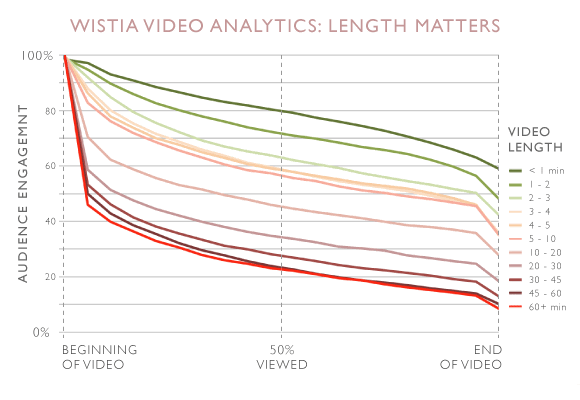
We are told that today’s students are addicted to their screens. It is true that it is hard for them to sit still for a traditional lecture, but switching to video doesn’t guarantee success. In fact, the majority of videos will not keep the attention of today’s students.
It may come as no surprise, but the shorter your video is, the more engaged your students will be. In fact, research shows that on average, engagement by videos peaks at six minutes. This doesn’t mean that your students will watch the first six minutes of any video equally. Instead, the longer length a video has, the less time of it students tend to watch. For example, students tended to watch only three minutes of videos that were twelve minutes long. For these longer videos, the decision to disengage came right at the the beginning, with an almost instant drop off at the beginning of the chart and a steady decline until a second drop off occurs at the end.

What researchers have concluded from this is that although we think screens are the desired medium for today’s students, nothing can really compare with personal interaction. Shanna Smith Jaggars, the assistant director of Columbia University’s Community College Research Center told the Wall Street Journal about massive open online courses:
“The most important thing that helps students succeed in an online course is interpersonal interaction and support,”
She also said that in Virginia, 32% of online students failed or withdrew from online courses, but only 19% did so in live instructor-led classes.
You can use this magnet of personal engagement to your advantage when producing your videos as well. Although each section of video has to be tightly packed with information, adding personalization, such as true life accounts and stories or real footage of events will make them feel more connected and keep listening.
If your videos are being shared online, it’s also the briefest ones that get the most responses and shares. Talking Tree Creative presented research by the Jun Group that said:
“Videos that are 15 seconds or shorter are shared 37 percent more often than those that last between 30 seconds and one minute. Videos that are 15 seconds or shorter are also shared 18% more than videos longer than one minute.”
With videos that short, you can’t do more than ask one question or present one sound bite idea. It is a good way to try and tempt readers to click on a more information link, but not a good way to teach a whole class. This modern power of the mini video also explains the rise of services such as Vine and Instagram.
Some tips to make your videos more engaging:
- Keep your video short and to the point.
- Put your most important information at the beginning. Since large numbers of students are tuning out before the end of even the shortest videos, you want to make sure that you transmit your major message before your audience stops listening.
- If you want to do a longer presentation, break up your video content into pieces. After each piece, conduct a quick oral quiz or discussion on what was just shown. This causes the audience member to renew their attention with each segue.
- Conclusions and wrap-ups make students tune out. Save the review of the major points for the after video chat and end your video abruptly.



















